Ladakh – once a royal kingdom, now a little pocket of Tibetan Buddhism in the Himalayas; where green stupa-dotted valleys nestle between snowcapped peaks, prayer flags flutter in the wind and ancient monasteries tumble down hillsides.
If you’re traveling around Ladakh you will stay in Leh, the regional hub, for at least a few days. Leh is a nice town with plenty of day trip options nearby, and it’s where you’ll likely organise your onward travel from. You can use tour agencies and private transport; Jeep Safaris are hugely popular and widely available. And they’re easy. But it’s also easy – and a lot cheaper – to just travel solo by public transport, and that’s what this post is about.
This guide tells you how to use public transportation – buses and shared jeeps – to daytrip in the Indus Valley around Leh, and to travel in the Nubra Valley.
Is Ladakh Safe?
Road Access
Phones, WiFi, Money
Around Leh – Indus Valley Monasteries
Day Tripping the Indus Valley by Bus
The Nubra Valley
Nubra Valley by Bus and Shared Jeep
Is Ladakh Safe?
Kashmir experiences more than its share of problems and turmoil, but Ladakh has always remained separate from the conflict. You should check the current situation as things can change, but safety isn’t generally an issue here. There is a more noticeable military presence and that’s about it.
Road Access
Road access to Leh/Ladakh is seasonal. The roads from Manali and Srinagar are open from May until October or November, with June to August being the peak season for the area. Flights in and out are regular, cheap and frequent.
Once in Ladakh, my usual concerns about riding around in buses and jeeps quickly vanished – the roads are good condition and so are the vehicles. Plus at this point I’ve just become immune to teetering on the edge of cliffs. Drivers seem to have a degree of responsibility here – the first one I met did the most astonishing thing: he pulled over before making a call.
You can expect quite a few military checkpoints in the Nubra Valley.
Phones, WiFi, Money
Leh has plenty of reliable ATMs so you can easily get money. You won’t find many ATMs outside of Leh so make sure you bring the cash you need when you travel. You should also get a sim card while you’re there. Even if you already have an Indian sim, you need a new J&K one up here because out-of-state sim cards won’t work. You can get one in the Main Bazaar on the big street that goes out towards the bus/taxi stands. AirTel has an office in a side street to the right. AirTel sims won’t work once you get out into the Nubra Valley but BSNL might. In Leh, guesthouses and cafes will have WiFi (but probably not that fast or reliable. Mine was down half the time). The places I stayed in the Nubra Valley claimed to have WiFi…but it almost never worked.
Around Leh – Indus Valley Monasteries
The Indus Valley surrounding Leh is sprinkled with little villages and gompas (Tibetan monasteries), all of which are easily reachable on day trips. You can hire a taxi to get around but that’s expensive, and taking the local bus is easy and cheap.
There is a string of villages in a line that you can visit in a day or two depending on how long you spend at monasteries: Choglamsar (which is basically a transport hub) – Shey – Thiksey – Kharu (where the road branches out in opposite directions to Chemrey or Hemis).
Shey
The ruins of a fortress and a restored royal palace from the 1600s. The palace temple houses a 7.5 metre tall Buddha from 1645. The village itself is overrun with white stupas, some of them 1000 years old. Shey also has accommodation and a couple of restaurants in the main road back to Leh which is handy if you are waiting there for a bus to pass by.
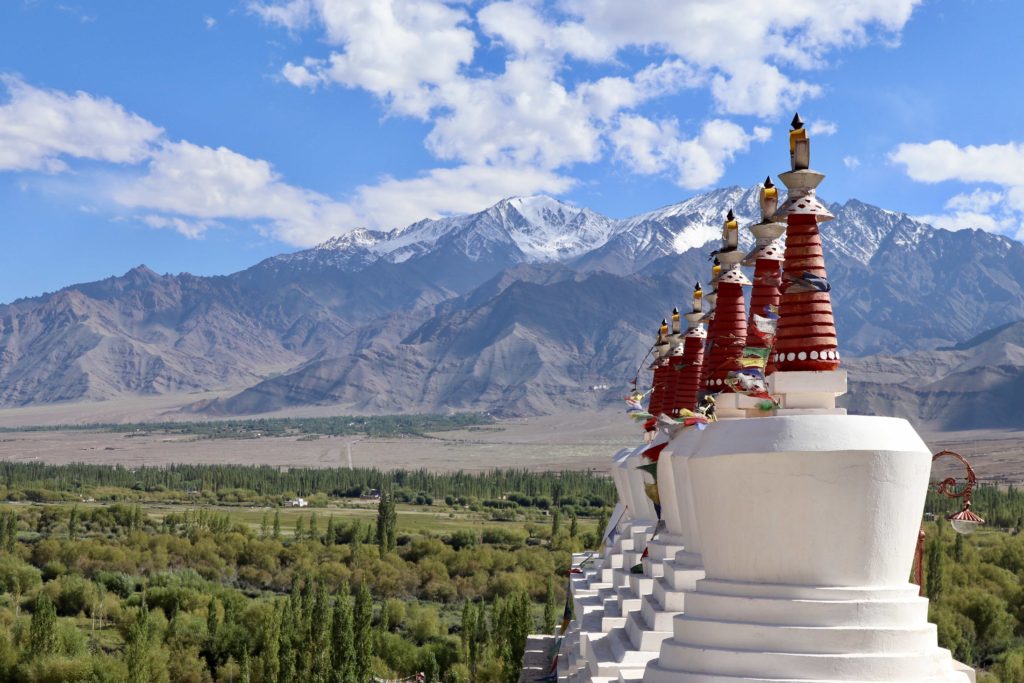
Thiksey
One the biggest gompas (Tibetan monasteries) in Ladakh. There is another enormous Buddha here, and the view of the monastery on the hilltop from outside and down below is really striking.

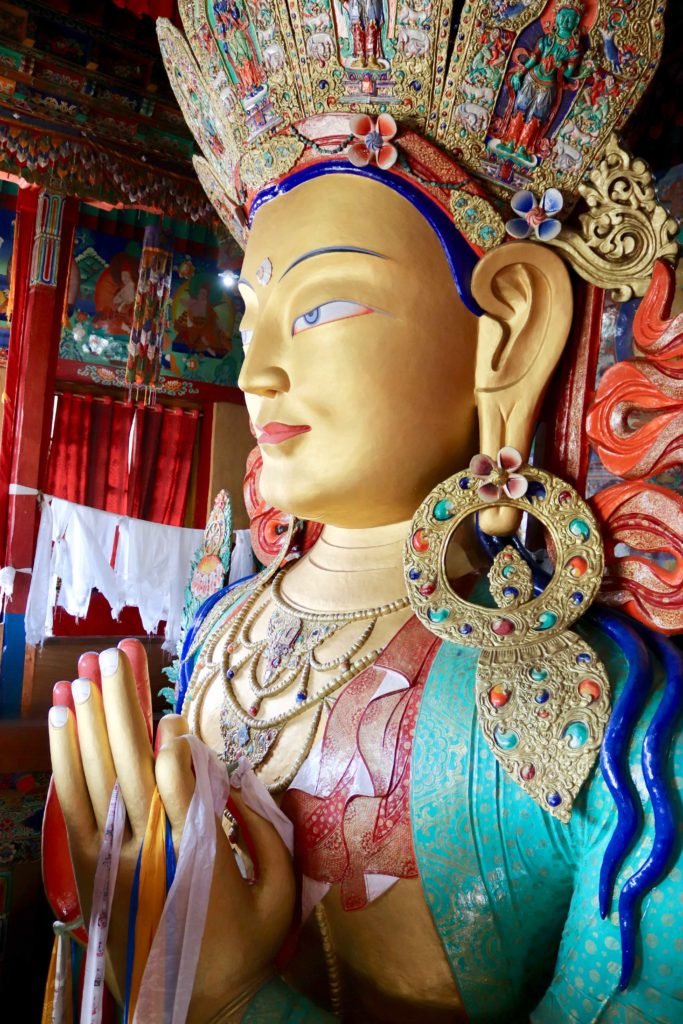
Chemrey
Another high-hilltop monastery (it’s a good steep climb), with beautiful views over the valley.
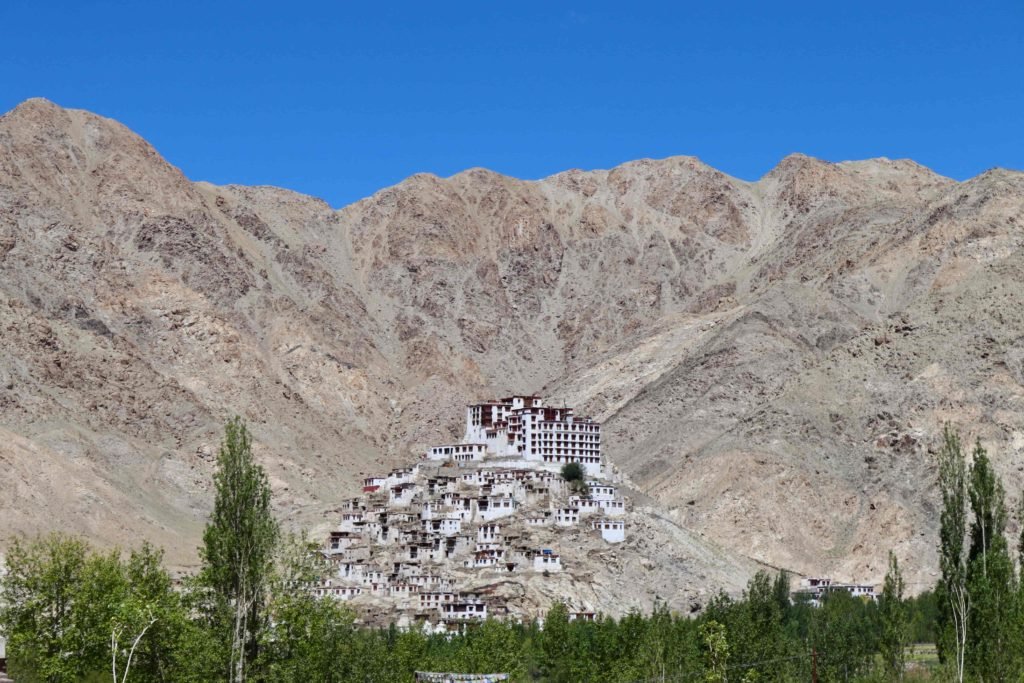
Hemis
Apparently the ‘famous’ one, this 17th century monastery is also the most popular of the lot. I didn’t visit this one myself.
Day Tripping the Indus Valley by Bus
Each leg of the trip is less than 10 kms along the Manali-Leh highway between Leh, Choglamsar, Shey and Thiksey. From Thiksey it’s another 15 kms or so to Kharu. From Kharu, Chemrey and Hemis are both about 7 kms off the main road in opposite directions. Buses ply the main road in both directions so you can travel in a straight line out and back hopping on and off as you go. Basically, I wouldn’t count on any set schedule.
You have a couple of options:
- From the old bus stand in Leh (maps.me – Main Gate), just out of the Moti Market, get a local bus to Choglamsar. They go when full, around every ten minutes starting at 8 or 8.30 in the morning until 8 pm. Get off at the small central bus stand in Choglamsar. Cross the street and catch the next bus going on to Shey and Thiksey.
- Or, take a local bus from Leh bound for Sakti, which also passes by Shey and Thiksey without you having to change in Choglamsar. These depart just once around 8 am and again hourly in the afternoon from approximately 1 until 4 pm.
- Or, from the main bus station in Leh (about a kilometer down the road from the old bus stand), get a bus going straight to Kharu. This will also pass by Shey and Thiksey on the way.
The trip is quick so watch for your stop. You’ll see the palace above Shey, and the gate for Thiksey gompa as they come up – tell the driver you want off. You pay him as you disembark.
The bus from Leh to Kharu costs around 50 rupees. It seems to be around 10 rupees per hop: so 10 rupees from Leh to Choglamsar, 10 more to Shey, 10 more to Thiksey.
To go to Chemrey or Hemis monasteries, take the bus from Leh or Choglamsar all the way to Kharu and get out in the main street there. Then you’ll need to hitch a ride or find a taxi for the last 7 kms to either monastery. Depending on the bus’s final destination (usually Martselang) it might carry on to Hemis.
To go back to Leh or further along the road in either direction, just stand in the main road out of the village you are in, and flag down the next passing bus going your direction. You can also try hitching. I didn’t find it that easy to hitch – a lot of vehicles passing seemed to be chartered taxis who obviously won’t pick you up.
The Nubra Valley
The beautiful Nubra Valley is a popular destination for Jeep Safaris: you arrange a group or join an existing one at any of the 1001 tour agents in Leh, and get a jeep and driver to take you out. It’s usually a two- to three-day tour. However, you don’t need to pay 3000+ rupees for a jeep to ferry you around for no reason – you can very easily get to the valley and travel around it by yourself on public transport.
The main village in Nubra Valley is Diskit. From Diskit you can visit Hunder as a day trip, and travel on to Turtuk which is the last village in India before the Line of Control (LOC) with Pakistan. Diskit and Turtuk are several hours’ drive apart, so I’d recommend staying a night or two in each.
Diskit’s got the only ATM in the valley, so bring cash from Leh. There is no electricity in the valley during the daytime (unless your guesthouse runs a generator). There is power for about three hours at night from 7 or 8 pm on, so be ready to charge up your devices (and to use the WiFi, if it works).
Permits
Foreigners need a permit to travel around in the Nubra Valley; they are easy to arrange. Do it in Leh the day before you go. Ask any travel agency in town if they issue permits, and drop your passport off in the morning. You can pick it up again the same evening. Permits are valid for up to 7 days and cost around 700 rupees. When you pick it up, make sure you get multiple copies of each page as you’ll have to give a copy to every checkpoint you pass on your way.
Diskit
There are quite a few guesthouses, some places to eat, and it’s a pretty and quiet place to walk around. There is, of course, a hilltop gompa and a seriously huge, vibrant Buddha overlooking the whole town.
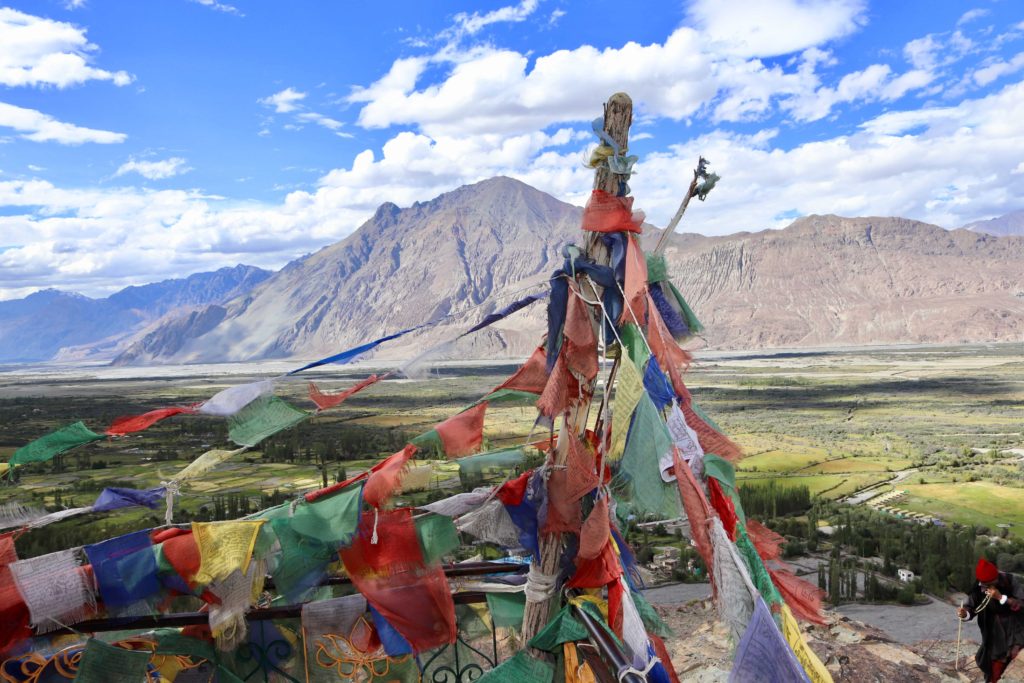
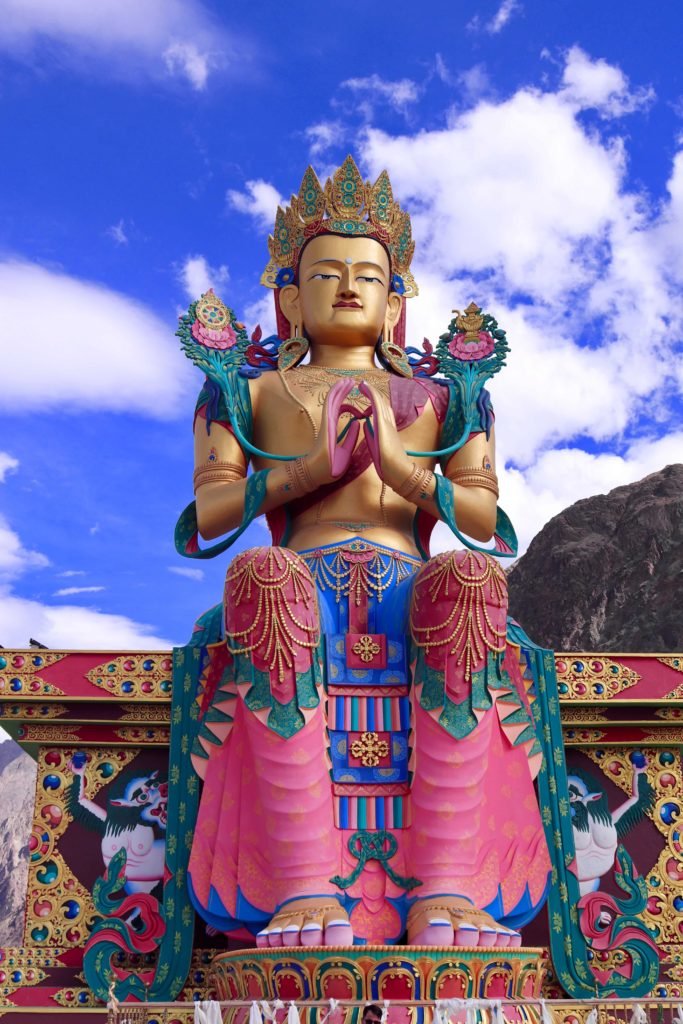
Hunder
As far as I could tell it isn’t so much a village as a horde of overpriced guesthouses and ‘lodges’. You’re better off daytripping from Diskit to see the rolling sand dunes (and ride the Bactrian camels there, that’s a hard ‘no’ for me).
Turtuk
A beautiful, tiny little village of barley fields and apricot orchards, dwarfed by the peaks of the Karakoram range. A wide rushing river divides the village; a rickety suspension bridge across joins it back up. There are no roads in the old part of the village and wandering around in the narrow lanes feels absolutely timeless.
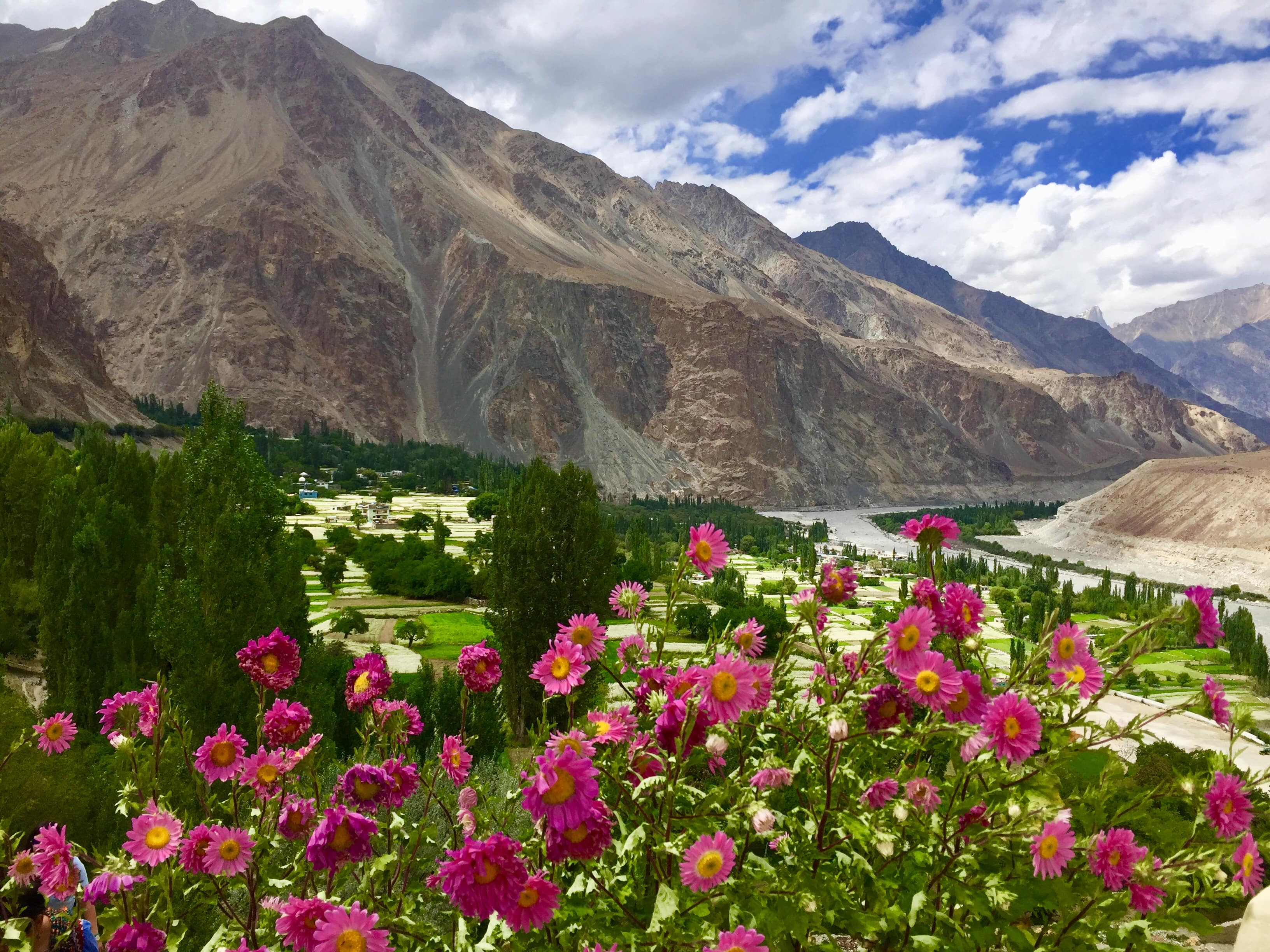
Nubra Valley by Bus and Shared Jeep
Diskit is about 115 kms from Leh, over Khardung La (5602 m), the ‘highest motorable mountain pass’ in the world. You have a couple of options for this scenic ride:
- There is one daily bus to Diskit from the main bus station in Leh. In summer it leaves at 7.30 am, costs about 250 rupees and takes most of the day.
- Or, get a seat in a shared jeep from the shared-taxi park just outside the Polo Ground in Leh. Show up early – jeeps leave when full by (hopefully) not much later than 8am. It takes about 4-5 hours and costs 400-500 rupees.
If you have an AirTel sim card, it will stop working somewhere around the pass. The trip ends at Diskit’s bus station (a parking lot in the bazaar).
To get from Diskit to Hunder, take a taxi from the bus station for around 300 rupees, or try to get a shared jeep from the shared-taxi park which is a long walk out of town towards Hunder. You can also take the once-daily bus to Turtuk from the Diskit bus station, and get off in Hunder. Or just walk…it’s 7 kms.
A bus goes from Diskit to Turtuk at 2.30 pm every day except Sunday. Check the day before, and buy a ticket in one of the shops across the road from the station. It’s 150 rupees and takes around 4 hours. Shared jeeps go from the shared-taxi park and cost around 300 rupees. They generally leave by midday, and take 3 hours. Alternatively, there is one bus per week from Leh all the way to Turtuk: it leaves at 6 am on Saturdays from Leh’s main bus station and takes 11 or 12 hours. It goes back the same way Sunday mornings.
From Turtuk shared jeeps go to Diskit daily around 6am. In Diskit you can connect with another jeep going to Leh, but they usually leave quite early. When I left Turtuk I found several other travellers going back to Leh and we organised our own jeep (with the help of Kharmang Guesthouse). It went all the way to Leh without stopping in Diskit and cost 700 or 800 rupees per person.
Read More
For more of my adventures (and misadventures) in India, check out the rest of my stories from the road.
And, if you’re looking for something different to do near Leh, how about a silence retreat in the Indus Valley? You can read about my experience at a three-day silence and meditation retreat, here. I also wrote a story about travelling around in Ladakh: Once Upon a Time in India.



